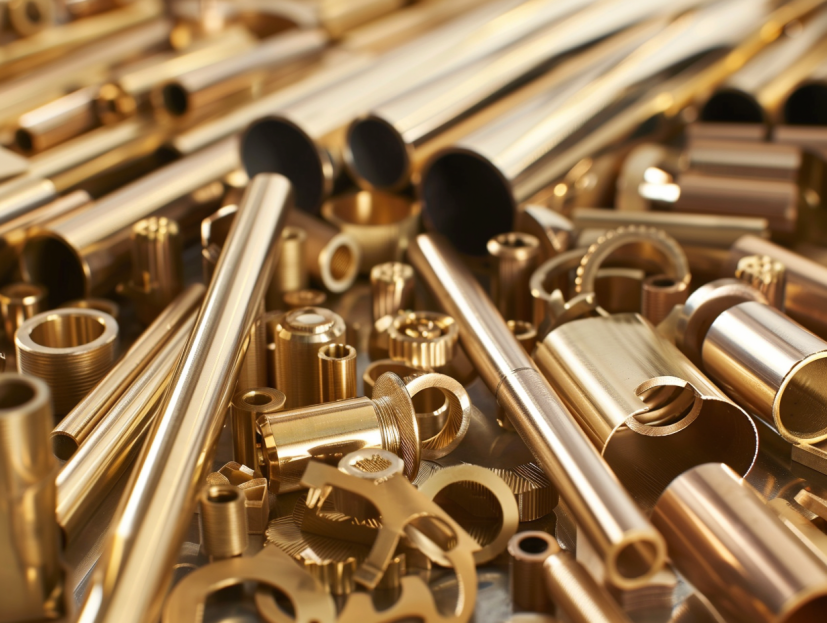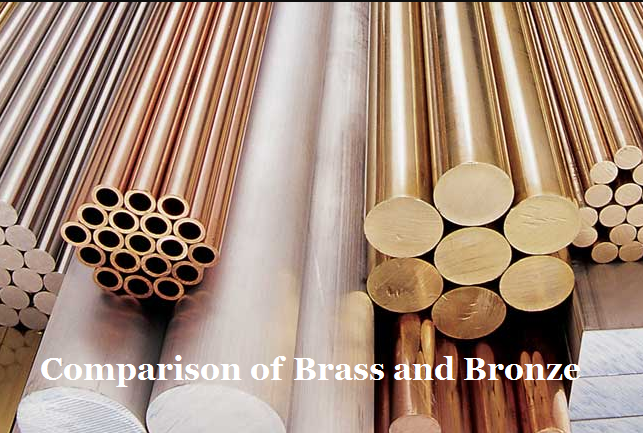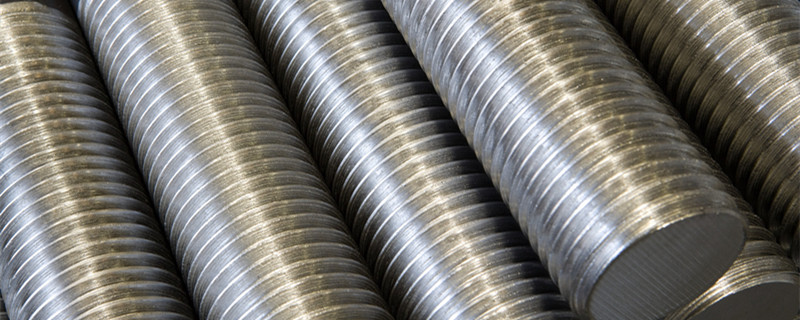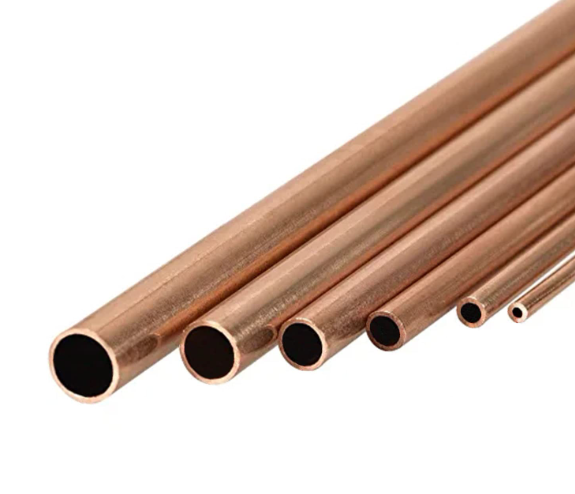Brass is a versatile and widely used alloy in the manufacturing industry, known for its golden hue and numerous applications. Among the various types of brass, red brass and yellow brass are particularly common, yet they have distinct differences that set them apart. This article explores what these two brass types are and how they differ in terms of composition, properties, applications, and price.

What is Red Brass?
Red brass (C23000), also known as rose brass, possesses a high copper composition of about 85%. This gives it a distinctive reddish hue. Red brass is particularly valued in the plumbing industry for its durability and corrosion resistance. It is also used for decorative purposes and in applications where resistance to zinc loss and seasonal cracking is important. Common uses include commercial water piping, decorative hardware, and musical instruments.
What is Red Brass Used For?
Red brass is commonly used for:
- Plumbing: Pipes and fixtures due to its corrosion resistance.
- Valves and Pumps: For industrial and marine applications.
- Marine Hardware: Boat fittings and other saltwater-exposed components.
- Ornamental Objects: Decorative items for its attractive reddish color.
- Musical Instruments: Some horns and bells for their rich tone.
- Gas Valves and Fittings: In low-pressure gas applications for durability.
- Fire Extinguishing Systems: Sprinkler systems components.
What is Yellow Brass?
Yellow brass (C26000) is characterized by its golden color, resulting from a typical copper content of about 60%. This type of brass has relatively good corrosion resistance, moderate strength, and excellent ductility in specific forms. Yellow brass is versatile and can be found in various forms such as rods, bars, sheets, and plates. It is widely used in the automotive industry, for plumbing components, decorative hardware, and musical instruments.
What is Yellow Brass Used For?
Here are the common applications of yellow brass:
- Musical Instruments: Trumpets, trombones, horns, and bells for its acoustic properties.
- Decorative Items: Door handles, trim, and fixtures for its gold-like appearance.
- Hardware: Gears, bearings, and fasteners because of its low friction and good wear resistance.
- Ammunition Casings: Its durability and workability make it suitable for cartridge casings.
- Radiator Cores: Due to its thermal conductivity and resistance to corrosion.
- Plumbing Accessories: Fittings and fixtures that do not require the high corrosion resistance of red brass.
- Electrical Components: Connectors and terminals for its conductivity and ductility.
Difference Between Red Brass and Yellow Brass
The differences between red brass and yellow brass are significant and can influence the choice of material for specific applications. Let’s break down these differences:
- Differences in Composition
Red Brass: Contains about 85% copper, with the remainder being zinc and small amounts of other elements. Some specific types of red brass may also contain arsenic to prevent corrosion from chlorinated water.
Yellow Brass: Generally has a copper content of around 60%, with the remainder being zinc and occasionally other elements to enhance its properties.
- Red vs Yellow Brass: Differences in Properties
Obviously, the proportions of metal elements in red brass and yellow brass are different, especially the proportion of copper. This largely determines that the two will have the following different physical properties:
Hardness
Red Brass: Softer due to higher copper content, with a hardness index of around 2.5-3 on the Mohs scale. Offers moderate strength suitable for forming and shaping.
Yellow Brass: Generally harder than red brass, with a hardness index of 3-4 on the Mohs scale. The increased zinc content contributes to its higher hardness and toughness.
Machinability
Red Brass: Adequate machinability, but slightly less than yellow brass. Suitable for applications requiring detailed shaping, such as intricate fittings.
Yellow Brass: Excellent machinability, making it a preferred material for components requiring precision manufacturing, like fasteners and gears.
Weldability
Red Brass: Easier to weld due to its composition. Preferred for applications where welding is necessary, such as pipes and fittings.
Yellow Brass: Weldability varies; with a zinc content higher than 20%, it can be welded well. Care must be taken during welding to avoid zinc fumes.
Conductivity
Red Brass: Exhibits superior electrical conductivity, often used as a benchmark (100% IACS). Chosen for electrical applications where high conductivity is required.
Yellow Brass: Lower electrical conductivity compared to red brass, around 28% IACS. Still used in electrical connectors and components where high conductivity is not critical.
Thermal Conductivity
Red Brass: Consistent thermal conductivity, which does not change significantly with temperature. Utilized in applications such as heat exchangers and radiators.
Yellow Brass: Thermal conductivity increases with temperature. Suitable for applications where this characteristic is advantageous.
Corrosion Resistance
Red Brass: Outstanding corrosion resistance, particularly in water applications. Often used for underground service lines and plumbing due to its longevity.
Yellow Brass: Good corrosion resistance, but may be prone to dezincification in certain environments. A thin protective patina forms when exposed to the atmosphere, providing additional protection against corrosion.
Durability
Red Brass: Highly durable with good retention of spring properties. Can maintain functionality with minimal maintenance under normal operating conditions.
Yellow Brass: Also durable but may require more maintenance to prevent corrosion, depending on the environment.
Density
Red Brass: With a higher copper content, red brass typically has a higher density. Copper’s density is about 8.96 grams per cubic centimeter (g/cm³). Since red brass is roughly 85% copper, its density will be closer to that of pure copper but slightly reduced by the presence of zinc. The density of red brass is approximately 8.4 to 8.7 g/cm³.
Yellow Brass: This alloy has a lower copper content and a higher proportion of zinc, which has a density of around 7.14 g/cm³. Therefore, yellow brass will have a lower density than red brass due to its higher zinc content. The density of yellow brass is typically in the range of 8.3 to 8.5 g/cm³.
- Red vs Yellow Brass: Differences in Applications
Red Brass: Common uses include fittings, nozzles, architectural fascia, marine hardware, door handles, and musical instruments like trombones.
Yellow Brass: Utilized for applications such as automotive parts, electrical connectors, plumbing components, decorative items, and also in musical instruments like saxophones.
- Red vs Yellow Brass: Differences in Prices
Red Brass: More expensive because of the higher copper content. Often recycled, adding value to scrap materials.
Yellow Brass: Less expensive but price can vary with market conditions for copper and zinc. Requires purification when recycled due to the presence of additional metals.
How To Tell Red Brass from Yellow Brass?
To distinguish between red brass and yellow brass, you can:
- Examine the Color: Red brass has a reddish tint, while yellow brass has a brighter, more gold-like hue.
- Check the Composition: If possible, determine the copper-to-zinc ratio; red brass has more copper.
- Test a Small Area: Use a file to gently sand a spot on the metal; orange shavings suggest red brass, while light yellow indicates yellow brass.
- Assess the Weight: Due to its higher copper content, red brass tends to weigh more than yellow brass.
- Consider the Application: If the item is a plumbing fixture or part, it is likely red brass, whereas decorative elements are often made of yellow brass.
Yellow Brass vs Red Brass, Which One To Choose?
Considerations for Choosing Between Red and Yellow Brass:
- Environment: If the material will be exposed to corrosive substances like seawater or certain chemicals, red brass may be the better choice.
- Application: For decorative items or where a gold-like appearance is desired, yellow brass is often preferred.
- Mechanical Requirements: If the part needs to be machined with high precision, yellow brass’s excellent machinability makes it a better option.
- Budget: If cost is a significant concern, yellow brass is usually less expensive due to its lower copper content.
- Electrical/Thermal Needs: When higher conductivity is needed, red brass is the better choice.
Red brass and yellow brass are both popular materials with distinct qualities that make them suitable for different uses. Red brass is favored for its durability and corrosion resistance, making it ideal for plumbing and high-quality applications. Yellow brass, with its bright appearance and good machinability, is often chosen for decorative purposes and components requiring moderate strength.
When selecting between the two, consider the specific needs of your project, including the desired properties, application environment, and budget constraints. By understanding their differences, you can make an informed decision to ensure the success and longevity of your end product. If you are looking for brass machining services, contact us to get the best suggestion!







